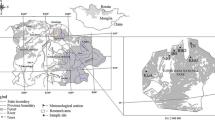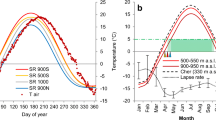Abstract
Tree growth has been hypothesized to provide a reliable indicator of the state of the external environment. Elevated levels of background ionizing radiation may impair growth trajectories of trees by reducing the annual growth. Such effects of radiation may depend on the individual phenotype and interact with other environmental factors such as temperature and drought. We used standardized growth rates of 105 Scots pine Pinus sylvestris located near Chernobyl, Ukraine, varying in the level of background radiation by almost a factor 700. Mean growth rate was severely depressed and more variable in 1987–1989 and several other subsequent years, following the nuclear accident in April 1986 compared to the situation before 1986. The higher frequency of years with poor growth after 1986 was not caused by elevated temperature, drought or their interactions with background radiation. Elevated temperatures suppressed individual growth rates in particular years. Finally, the negative effects of radioactive contaminants were particularly pronounced in smaller trees. These findings suggest that radiation has suppressed growth rates of pines in Chernobyl, and that radiation interacts with other environmental factors and phenotypic traits of plants to influence their growth trajectories in complex ways.





Similar content being viewed by others
References
Arkhipov NP, Kuchma ND, Askbrant S, Pasternak PS, Musica VV (1994) Acute and long-term effects of irradiation on pine (Pinus sylvestris) stands post-Chernobyl. Sci Total Environ 157:383–386
Carrer M, Urbinati C (2004) Age-dependent tree-ring growth responses to climate in Larix decidua and Pinus cembra. Ecology 85:730–740
Ceulemans R, Mousseau M (1994) Effects of elevated atmospheric CO2 on woody plants. New Phytol 127:425–446
Cherubini P, Gartner BL, Tognetti R et al (2003) Identification, measurement and interpretation of tree rings in woody species from Mediterranean climates. Biol Rev 78:119–148
Cohen J (1988) Statistical power analysis for the behavioral sciences. Erlbaum, Hillsdale
Cook ER, Kairiukstis LA (eds) (1990) Methods of dendrochronology: applications in the environmental sciences. Kluwer Academic, Dordrecht
Dighton J, Tugay T, Zhdanova N (2008) Fungi and ionizing radiation from radionuclides. FEMS Microbiol Lett 281:109–120
Fritts HC (1976) Tree rings and climate. Academic Press, London
Haylock MR, Hofstra N, Klein Tank AMG, Klok EJ, Jones PD, New M (2008) A European daily high-resolution gridded dataset of surface temperature and precipitation. J Geophys Res (Atmospheres) 113:D20119. doi:10.1029/2008JD10201
Kagawa A, Aoki T, Okada N, Katayama Y (2002) Tree-ring strontium-90 and cesium-137 as potential indicators of radioactive pollution. J Environ Qual 31:2001–2007
Kal’chenko VA, Fedotov IS (2001) Genetic effects of acute and chronic ionizing irradiation on Pinus sylvestris L. inhabiting the Chernobyl meltdown area. Russ J Genet 37:341–350
Kal’chenko VA, Arkhipov NP, Fedotov IS (1993a) Mutations of enzyme loci, induced in megaspores of Pinus sylvestris L. by ionizing radiation after the accident at the Chernobyl Atomic Power Plant. Genetika 29:266–273
Kal’chenko VA, Rubanovich AV, Fedotov IS, Arkhipov NP (1993b) Genetic effects of the Chernobyl meltdown on the germline cells of common pine Pinus sylvestris L. Genetika 29:1205–1212
Kashparov VA, Lundina SM, Kadygriba AM, Protsaka VP, Levtchuka SE, Yoschenkoa VI, Kashpurb VA, Talerko NM (2000) Forest fires in the territory contaminated as a result of the Chernobyl accident: radioactive aerosol resuspension and exposure of fire-fighters. J Environ Radioact 51:281–298
Koch GW, Sillett SC, Jennings GM, Davis SD (2004) The limits to tree height. Nature 428:851–854
Kovalchuk O, Dubrova YE, Arkhipov A, Hohn B, Kovalchuk I (2000) Wheat mutation rate after Chernobyl. Nature 407:583–584
Kovalchuk O, Burke P, Arkhipov A, Kuchma N, James SJ, Kovalchuk I, Pogribny I (2003) Genome hypermethylation in Pinus sylvestris of Chernobyl—a mechanism for radiation adaptation? Mutat Res 529:13–20
Larsson L (2008a) CooRecorder Program of the CDendro Package Version 7.1. http://www.cybis.se
Larsson L (2008b) CDendro Program of the CDendro Package Version 7.1. http://www.cybis.se
Møller AP, Jennions MD (2002) How much variance can be explained by ecologists and evolutionary biologists? Oecologia 132:492–500
Møller AP, Mousseau TA (2006) Biological consequences of Chernobyl: 20 years after the disaster. Trends Ecol Evol 21:200–207
Møller AP, Mousseau TA (2007a) Determinants of interspecific variation in population declines of birds from exposure to radiation at Chernobyl. J Appl Ecol 44:909–919
Møller AP, Mousseau TA (2007b) Species richness and abundance of birds in relation to radiation at Chernobyl. Biol Lett 3:483–486
Møller AP, Mousseau TA (2008) Reduced abundance of raptors in radioactively contaminated areas near Chernobyl. J Orn 150:239–246
Møller AP, Mousseau TA (2009) Reduced abundance of insects and spiders linked to radiation at Chernobyl 20 years after the accident. Biol Lett 5:356–359
Rubanovich AV, Kal’chenko VA (1994) Altered segregation in Pinus sylvestris L. populations exposed to chronic irradiation in the region of the Chernobyl meltdown. Genetika 30:126–128
SAS Institute Inc (2012) JMP version 10.0. SAS Institute Inc., Cary, NC
Schmitt U, Grünwald C, Eckstein D (2000) Xylem structure in pine trees grown near the Chernobyl Nuclear Power Plant/Ukraine. IAWA J 21:379–387
Shestopalov VM (1996) Atlas of Chernobyl exclusion zone. Ukrainian Academy of Science, Kiev
Shevchenko VA, Abramov VI, Kal’chenko VA et al (1996) Genetic consequences induced in plant populations as a result of radioactive environmental pollution after the Chernobyl meltdown. Radiat Biol Radioekol 36:531–545
Ufar K (2007) Dendrochronology and past human activity: a review of advances since 2000. Tree Ring Res 63:47–60
Woodwell GM, Miller LN (1963) Chronic gamma radiation affects the distribution of radial increments in Pinus rigida stems. Science 139:222–223
Yablokov AV, Nesterenko VB, Nesterenko AV (2009) Chernobyl: consequences of the catastrophe for people and nature. New York Academy of Sciences, New York
Yoschenko VI, Kashparov VA, Levchuk SE, Glukhovskiy AS, Khomutinin YV, Protsak VP, Lundin SH, Tschiersch J (2006a) Resuspension and redistribution of radionuclides during grassland and forest fires in the Chernobyl exclusion zone: part II. Modeling the transport process. J Environ Radioact 87:260–278
Yoschenko VI, Kashparov VA, Protsak VP, Lundin SM, Levchuk SE, Kadygib AM, Zvarich SI, Khomutinin YV, Maloshtan IM, Lanshin VP, Kovtun MV, Tschiersch J (2006b) Resuspension and redistribution of radionuclides during grassland and forest fires in the Chernobyl exclusion zone: part I. Fire experiments. J Environ Radioact 86:143–163
Zakharov VM, Krysanov EY (eds) (1996) Consequences of the Chernobyl catastrophe: environmental health. Center for Russian Environmental Policy, Moscow
Acknowledgments
We are grateful for logistic help during our visits to Ukraine and Belarus from M. Bondarkov and A. Litvinchuk. We also thank L. Dobbs for assistance with radio-dosimetry at USC. We received funding from the University of South Carolina School of the Environment, Bill Murray and the Samuel Freeman Charitable Trust, the National Science Foundation, NATO, the Fulbright Program, CRDF and the National Geographic Society to conduct our research. We acknowledge the E-OBS dataset from the EU-FP6 project ENSEMBLES (http://www.ensembles-eu.org) and the data providers in the ECA&D project (http://eca.knmi.nl).
Author information
Authors and Affiliations
Corresponding author
Additional information
Communicated by A. Braeuning.
Rights and permissions
About this article
Cite this article
Mousseau, T.A., Welch, S.M., Chizhevsky, I. et al. Tree rings reveal extent of exposure to ionizing radiation in Scots pine Pinus sylvestris . Trees 27, 1443–1453 (2013). https://doi.org/10.1007/s00468-013-0891-z
Received:
Revised:
Accepted:
Published:
Issue Date:
DOI: https://doi.org/10.1007/s00468-013-0891-z




